

Max Davies
2026 GWM Haval Jolion review
6 Hours Ago
The entry-level Hyundai Santa Fe goes a long way to change perceptions of what a base model should be. It's not perfect, but it's compelling.



Marketplace Editor
New from
$57,800
excl. on-roads

Marketplace Editor
New from
$57,800
excl. on-roads


Marketplace Editor
New from
$57,800
excl. on-roads

Marketplace Editor
New from
$57,800
excl. on-roads
Quickly see how this car stacks up against its competition. Select any benchmark to see more details.
Where expert car reviews meet expert car buying – CarExpert gives you trusted advice, personalised service and real savings on your next new car.
In the automotive world, a mid-life refresh is usually a minor nip and tuck of the exterior and interior of a vehicle to keep it fresh for a few more years. Clearly, Hyundai didn’t get the memo.
Despite being billed as an updated version of the vehicle before it, the 2021 Hyundai Santa Fe shoehorns an all-new platform shared with the latest Kia Sorento and Carnival beneath its revised body, bringing with it more space, new engines, and enhanced technologies.
It’ll serve as the basis for the first Santa Fe Hybrid – due in Australia later in 2021 – and also sees a host of new equipment fitted as standard across the range.

The bulk of the changes have been applied to the higher grades, which offer all-digital driver’s instruments, a cool new interior layout inspired by the Palisade, and a new widescreen infotainment system measuring 10.25 inches.
However, here on test we have the base Santa Fe (simply named Santa Fe), which for under $50,000 forgoes the bulk of the glitzy upgrades.
It draws on a heavily reworked turbo-diesel engine and a new dual-clutch auto through, and packs some of the latest active safety features Hyundai has to offer.
Could this be the value pick of the 2021 Hyundai Santa Fe range?

Pricing for the 2021 Hyundai Santa Fe line-up starts at $44,700 plus on-road costs for the entry-level ‘Santa Fe’ with the V6 petrol front-wheel drivetrain.
On test we have that base grade with the optional 2.2-litre turbo-diesel and all-wheel drive, which costs $48,200 before on-roads.
The range continues upwards with the Active (from $48,300), Elite (from $54,300) and flagship Highlander (from $61,700).
All trim levels come with the option of V6 petrol front-wheel drive and four-cylinder turbo-diesel with all-wheel drive. The latter commands a circa $3500 premium over the former.
For reference, the base Kia Sorento S Diesel AWD is $52,190 drive-away, the diesel-powered Mazda CX-8 Sport is $46,910 list, and the Volkswagen Tiguan Allspace 140TDI Highline is $54,690 list.

Buy your new car without the stress. It's fast, simple and completely free.

Great service from Travis and team, second time I have used this business would not hesitate to recommend them to anyone
Craig C.
Purchased a Ford Ranger in Sunshine Coast, QLD
CarExpert helped Craig save thousands on his Ford Ranger, now let us save you on your next new car.
Find a dealThe base Santa Fe comes with the following standard equipment:

In addition to the above, it comes loaded with standard driver assistance systems which we’ll touch more on the safety gear in the next section.
Overall, Hyundai has done a good job decking out the base Santa Fe with plenty of kit so it doesn’t feel like an entry variant.
The only real omission at this trim level is the cool new dashboard and centre console design that features on all trim levels bar the base grade.
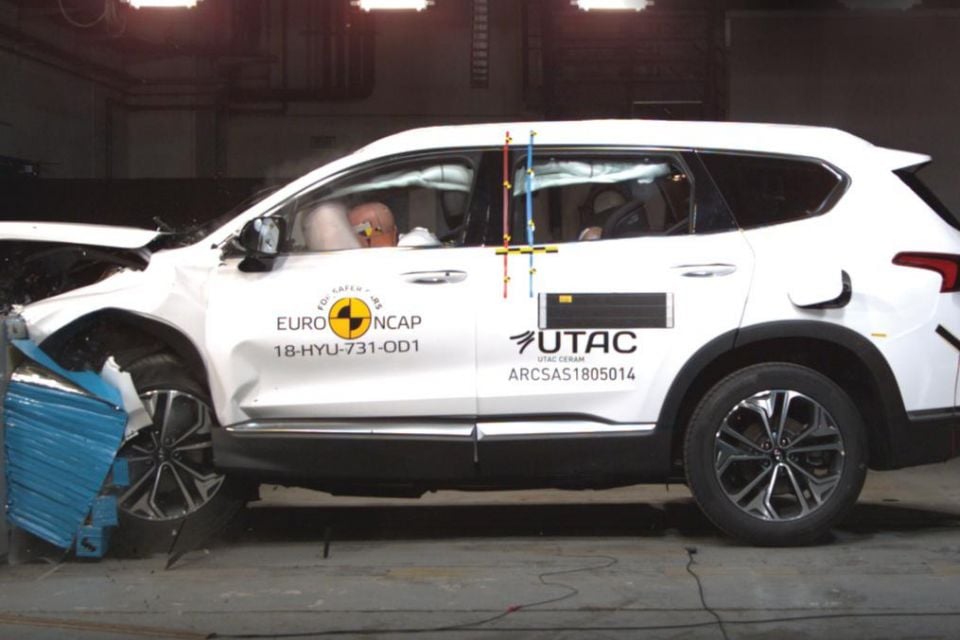
All versions of the Hyundai Santa Fe wear a 2018-stamped five-star ANCAP safety rating, based on tests conducted by Euro NCAP.
This rating carries over for the facelifted range too.
The Santa Fe scored 94 per cent for adult occupant protection, 86 per cent for child occupant protection, 67 per cent for vulnerable road user protection and 78 per cent for safety assist.

All versions of the Hyundai Santa Fe come fitted with the following driver assistance features:
Dual frontal airbags, side chest and side head-protecting airbags (curtains) are standard, as well as ISOFIX child seat mounts on the outboard rear seats.

Unlike the wider range, the entry-level Santa Fe doesn’t gain the new dashboard and centre console design inspired by the Palisade.
Not that the outgoing model’s layout had anything wrong with it, but it’s a bit odd the base model gets a completely different interior look and feel.
With that in mind this variant feels familiar, with an ergonomically sound cockpit, a mix of soft-touch and harder plastics, and comfortable front seats.
The standard leather steering wheel and shifter are a nice touch, and the high-resolution 8.0-inch floating touchscreen looks the goods too – until you try using the wireless smartphone mirroring.



Given there’s no native satellite navigation, you need to rely on your smartphone for mapping. You can imagine how frustrating it is, then, when wireless CarPlay drops out constantly while you’re driving.
This is an issue common to all the Hyundai/Kia products we’ve tested recently with wireless smartphone mirroring, and the brands have acknowledged the fault. A fix is said to be on the way. We just don’t know when.
When it was working, though, the Santa Fe’s touchscreen offered great response times and good integration of my iPhone’s apps and functions, and the standard sound system offers good quality audio.
Most functions up front are manual – think the driver’s seat adjustment, steering wheel column adjustment, key ignition, and the air-conditioning system.




Sure, climate control and electric seat adjustment would be nice, but everything is functional and easy to use. If you really want those convenience functions plus the new interior layout, you’ll have to splurge at least $48,300 for the Santa Fe Active.
As noted earlier, comfort up front is top-notch. The fabric seat trim is soft to the touch and the seat itself is supple and supportive.
There’s a healthy amount of bolstering too, meaning you’re in a comfortable chair that holds you in when you’re going through corners. I’d have these over leather any day.
As tends to be the case with most large SUVs, there’s a feeling of airiness and spaciousness up front thanks to the vehicle’s width and tall roofline.






Storage up front is pretty good, with decent sized door pockets, a large cubby under the centre stack with USB outlets and a wireless phone charge pad, two cupholders between the front seats, and a healthy storage bin under the front centre armrest.
Moving into the second row, the Santa Fe offers an impressive amount of space in keeping with its family focus, and can even squeeze three adults across for short journeys. Head- and legroom are good for even larger adults.
There’s rear air vents and more USB ports for charing mobile devices, as well as a small cubby under the vents, map pockets behind the front seats and bottle holders in the rear doors.
A fold-down centre armrest brings an additional par of cupholders, and there’s ISOFIX child seat mounts on the outboard seat positions.




In Australia the Santa Fe comes with seven seats as standard, though the third row is still best left for kids on anything more than short journeys.
There are vents back there and separate fan controls, but there aren’t additional ISOFIX and top-tether points in row three like you’ll find in the related Kia Sorento. It’s also worth noting the curtain airbags don’t stretch to fully cover the third row like you’ll find in numerous rivals.
With the third row in place, there’s 130L of luggage capacity. In five-seat configuration there’s between 571L and 782L depending on how far forward they’re slid.
Folding row two and three liberates 1649L of cargo-carrying volume. Unlike many competing models, the Santa Fe’s under-floor storage area in the boot can fit the cargo cover, which is a convenient touch.

Two powertrains are available in the local Santa Fe line-up, at least for now.
On test we have the optional 2.2-litre four-cylinder turbo-diesel with all-wheel drive, paired with a new eight-speed wet-type dual-clutch automatic. Outputs are rated at 148kW (at 3800rpm) and 440Nm (between 1750 and 2750rpm)
This engine is a heavily revised version of the oiler from the previous Santa Fe.
With a lighter aluminium construction and a quick-shifting DCT, Hyundai claims the new diesel not only saves weight and fuel (up 19 per cent more efficient), but should also be a better performer.

Where expert car reviews meet expert car buying – CarExpert gives you trusted advice, personalised service and real savings on your next new car.
That shows in the official fuel consumption claim, which is now listed as 6.1L/100km on the combined cycle compared to the previous model’s 7.5L/100km. We managed in the sevens with mixed driving.
Buyers can save $3500 and opt for the 200kW/331Nm 3.5-litre naturally-aspirated V6 petrol, though that removes the all-wheel drive option and raises the claimed fuel economy figure to a thirsty 10.5L/100km.
Later this year, Hyundai will launch the first Santa Fe Hybrid in Australia, complete with a 169kW/350Nm 1.6-litre turbo petrol hybrid setup with all-wheel drive. While a fuel figure hasn’t been confirmed yet, the hybrid should be competitive with the diesel on the economy front.

Having had plenty of experience with the Hyundai 2.2-litre diesel, I was interested to see if there was any difference between the Santa Fe and Sorento given both have recently moved to dual-clutch autos.
In my review of the top-spec Sorento GT-Line Diesel AWD, I found the DCT could be a little elastic at launch and when shifting from first into second. However, I didn’t really experience the same in the Santa Fe apart from the odd moment of lag when setting off or an awkward crawl when parking on an incline.
Hyundai’s version of the 2.2TD and DCT combo seems to be a touch smoother and more refined, and engine noise is impressively hushed.
Diesels have copped a bad name lately due to emissions scandals and whatnot, but the Santa Fe demonstrates there’s still a place for oilers in 2021.
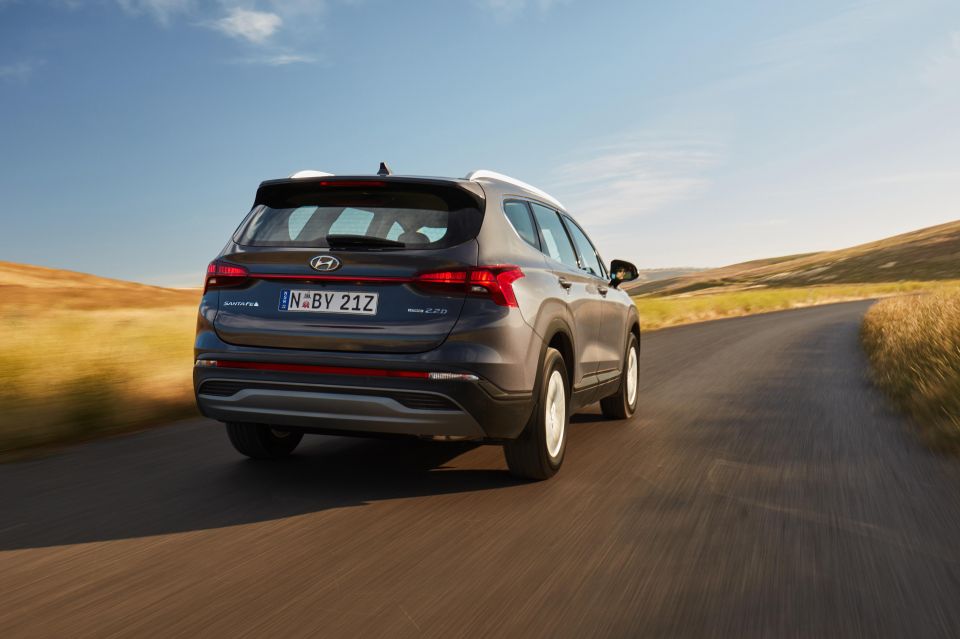
There’s effortless acceleration from a standstill thanks to all 440Nm being available from 1750rpm. Even with a carload of passengers, the diesel-powered Santa Fe gets along without a fuss.
It really is at home on the open road, where the transmission settles into its highest ratio and the engine hums away silently below 2000rpm.
The ride is fantastic in just about any situation, thanks to both the locally-tuned suspension setup and the chubby 235/65 R17 tyres.
While the suspension errs on the firmer, sporty side, it’s never uncomfortable and does a good job at isolating the cabin from the various lumps and bumps you’ll find in the city and on country highways.
Refinement at speed is also impressive. Road and wind noise are pretty hushed which lends an almost luxurious ambience on the move. The Santa Fe’s road holding at speed is confidence inspiring, which means you can really eat up the miles in comfort with the big Hyundai.

All the controls – i.e. the steering, accelerator and brake pedals – are well-weighted and progressive, making them easy to modulate. The result is smooth, predictable outputs.
The steering has a really nice and balanced feel, offering good weight while also making manoeuvring this rig around the city a cinch. At speed there’s still enough weight and feel to inspire confidence and communicate what the front wheels are doing effectively.
While this is a big, heavy family bus, the Santa Fe’s well-weighted controls mean it’s a nice thing to pilot up a winding road. Sure, it doesn’t put the ‘sport’ in SUV but you’ll feel good gracefully navigating a series of bends.
Our week with the Santa Fe also gave us a chance to get a good idea of how its assistance suite works. The adaptive cruise and lane centring functions work very well, likewise the standard blind-spot monitoring and rear cross-traffic alerts.
Props to Hyundai too, for including reflector-type LED headlights as standard. They’re notably brighter than the old model’s halogens.
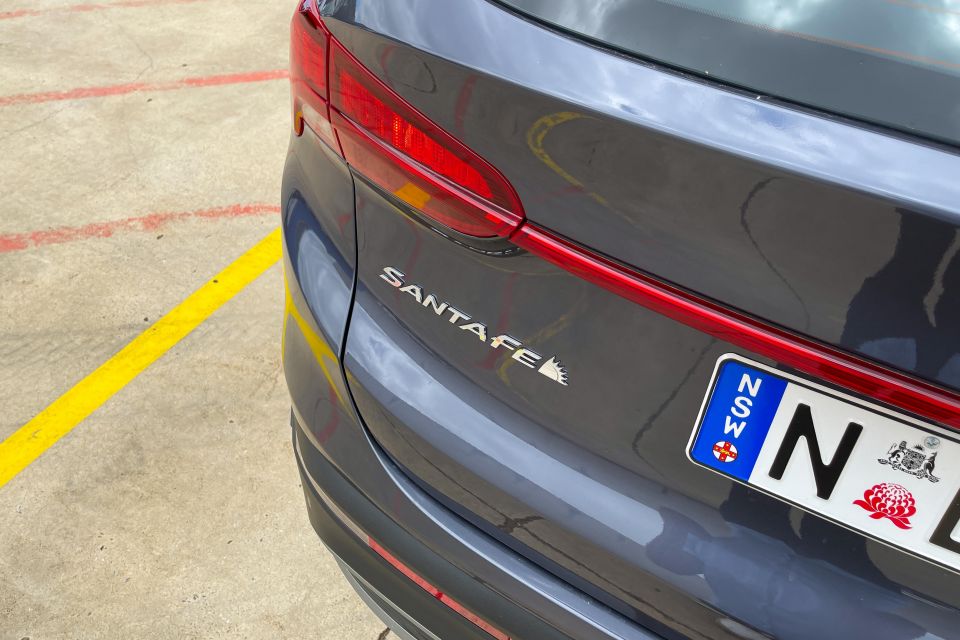
The Hyundai Santa Fe is covered by a five-year, unlimited-kilometre warranty with lifetime capped-price servicing.
You can purchase a pre-paid servicing plan covering three, four or five years, priced at $1377, $1836 and $2295 respectively for the diesel model we have on test.
Should you opt for the V6 petrol, servicing is more affordable at $1197, $1596 and $1995 for the same intervals.
Maintenance is required every 12 months or 15,000 kilometres, whichever comes first.
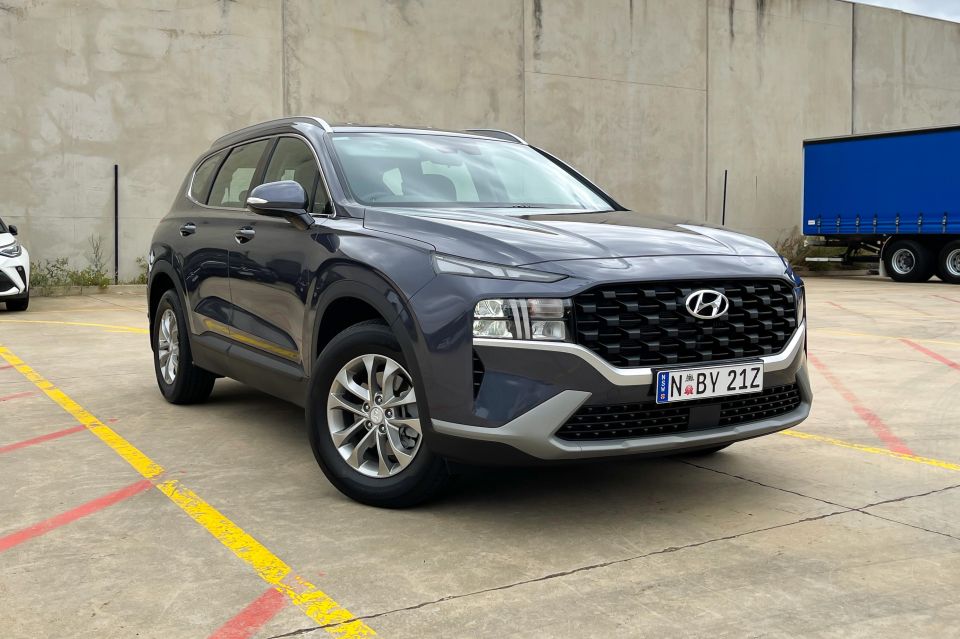
While most of the hype and new technology is focused around the higher trim levels, the base Hyundai Santa Fe is a comfortable, efficient and well featured family SUV that is more than worthy of your consideration.
Frustrating infotainment quibbles aside, the seven-seat capacity, large boot and suite of safety systems are key selling points, as are the punchy turbo diesel, pliant locally-tuned ride, and well-finished cabin.
Personally though, I’d label the Santa Fe Active the value pick given it packs upgrades like the swish new dashboard layout as well as climate control air-con, front parking sensors, keyless start and auto wipers for not a whole lot more.

Click the images for the full gallery
MORE: Hyundai Santa Fe news, reviews, comparisons and videos
Where expert car reviews meet expert car buying – CarExpert gives you trusted advice, personalised service and real savings on your next new car.
James Wong is an automotive journalist and former PR consultant, recognised among Australia’s most prolific motoring writers.


Max Davies
6 Hours Ago


Damion Smy
16 Hours Ago


Max Davies
22 Hours Ago
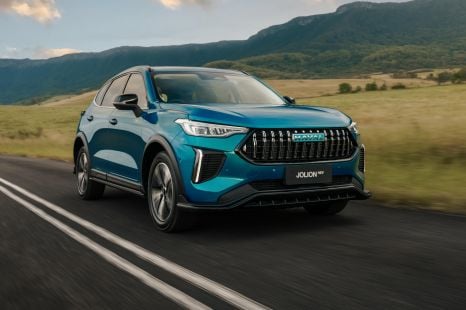

Max Davies
3 Days Ago


Damion Smy
4 Days Ago


William Stopford
15 Days Ago